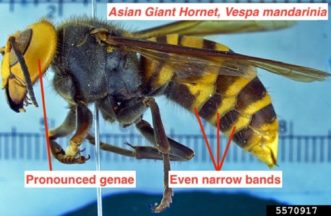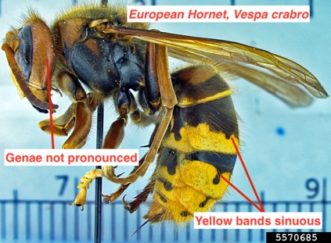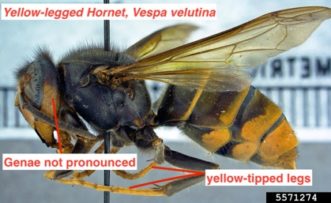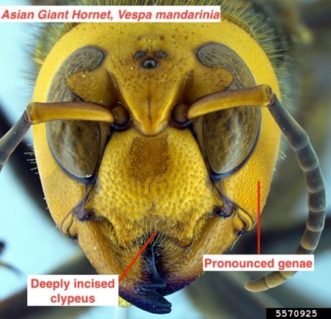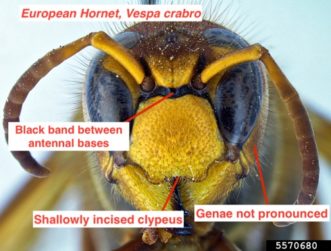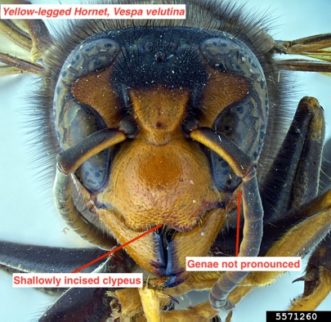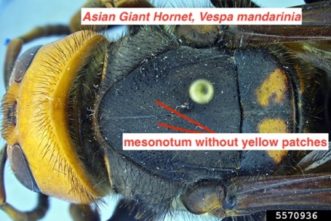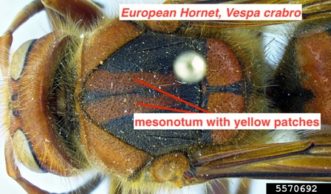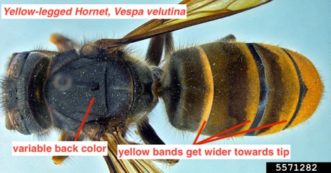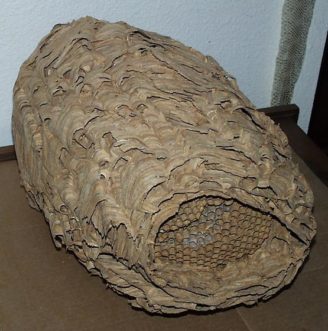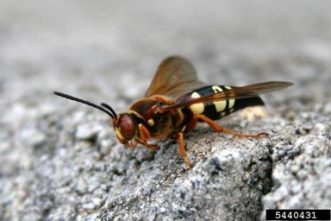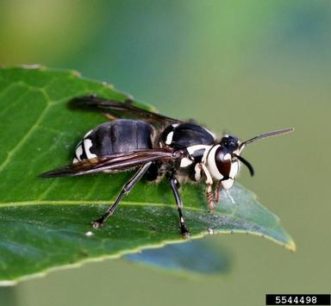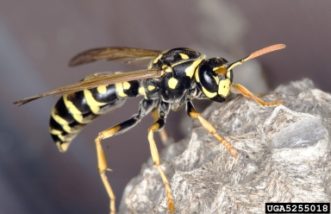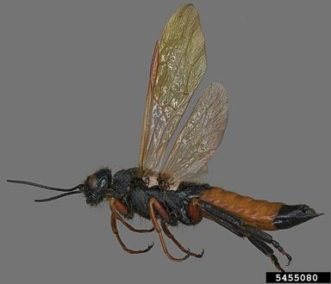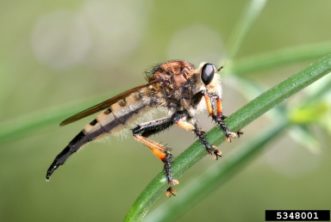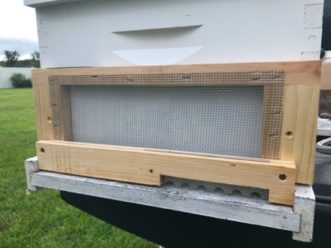Exotic hornets present a significant threat to apiculture. Recent introductions of the northern giant hornet (NGH) to North America and the yellow-legged hornet (YLH) to Europe, both known to attack and destroy honey bee colonies, have made it critical for beekeepers, regulators, and the general public to be able to detect and identify these exotic hornets. A basic understanding of hornet biology and diagnostic characteristics will help with early detection and management to minimize the potential impacts on apiculture in the eastern United States if they are introduced to the region.
Introduction
The Importance of Apiculture
Worldwide, western honey bees (Apis mellifera) are critical for modern agriculture, pollinating many crops and producing tangible goods such as honey, beeswax, and other hive products. In the United States, western honey bees are essential pollinators of almonds, cherries, blueberries, and several other fruit crops. Western honey bees also increase the production and profitability of many other crops and livestock forages, contributing more than $20 billion to the US economy.1 Honey bees are important to South Carolina, which has a growing apiculture industry and hosts dozens of commercial migratory beekeepers who manage thousands of beehives. In recent decades, the number of honey bee colonies in the United States has declined due to several factors, including the introduction of exotic pests such as small hive beetles and varroa mites.2 Beekeepers manage current pests, but there is concern that the introduction of other exotic pests of honey bees could further contribute to colony losses and increase beekeeper management expenses.
Predators of Honey Bees
Honey bees have many predators. Numerous birds, reptiles, mammals, spiders, and other insects eat honey bees, preying mostly on worker bees while they are foraging.3 Healthy honey bee colonies can overcome these losses, so most predators do not negatively impact honey bee colonies. A few predators brave the defenses of the honey bee colony to target the larvae. In the southeastern United States, only black bears and striped skunks attack and destroy honey bee hives for their contents.3 The only other predator of honey bee larvae present in the southeastern United States is the small hive beetle, Aethina tumida. The small hive beetle is an exotic pest of honey bees that was introduced to the southeastern United States in 1996 and subsequently spread across the nation and into Canada and Mexico. This exotic beetle has become one of the most significant pests of western honey bees in the United States.3 Because of the damage caused by small hive beetles and other exotic pests, beekeepers are very concerned about the introduction of other exotic pests and predators.
Exotic Hornets Pose a Threat to US Apiculture
Two species of hornets, the northern giant hornet (NGH), Vespa mandarinia, and the yellow-legged hornet (YLH), Vespa velutina nigrithorax, are of great concern to beekeepers worldwide. Both species are known to cause honey bee colony losses in their native ranges, and both species have been spread by human commerce to foreign locations.4,5 Insects in the genus Vespa are known as the “true hornets” and are exceptional predators. Hornets are social insects, living in family groups that establish territory and coordinate hunting for other insects by marking prey with pheromones to direct nest-mates to the food source. Hornets are large enough to overpower most other insects and have an exoskeleton thick enough to ward off other stinging insects. Most hornets prey on other insects’ larvae, and many species of hornets target nests of other social bees and wasps. Hornets also can sting, which makes them some of the most formidable predators in the insect world.
The genus Vespa contains about two dozen species worldwide.6,7,8 All but two of these species are native to southern and eastern Asia. The European hornet (EH), Vespa crabro, has a home range across Europe and western Asia. The Oriental hornet, V. orientalis, is found in the Middle East, the eastern Mediterranean, and across northern and eastern Africa. No true hornet species are native to North or South America; however, a distantly related group of North American wasps, the yellowjackets (Dolichovespula and Vespula), are sometimes called “hornets” by the general public. One species, commonly called the baldfaced hornet, Dolichovespula maculata (figure 6), is not a true hornet. The baldfaced hornet is more closely related to yellowjackets. It is much smaller than most species of Vespa and does not attack honey bee colonies.
Several species of hornets have expanded their ranges, mainly due to human assistance. In the 1800s, the EH was introduced into the United States, where it quickly spread across eastern North America.6 The EH is now commonly found from the southeastern US north to Canada and west to the Rocky Mountains. In 2003, the YLH, originally from southeast Asia, was introduced to Japan and the Korean peninsula, where it is killing honey bee colonies.9 In 2004, the YLH was introduced in France. It has spread to neighboring countries where it is killing honey bee colonies and has become one of the greatest threats to apiculture in Western Europe.10 In 2016, the greater banded hornet, Vespa tropica (L), was found for the first time in Guam. The greater banded hornet is known to attack the nest of other social Hymenoptera, including honey bees, but the impact of the greater banded hornet on Guam’s native ecosystems is yet to be determined.11 Most recently in 2019, the NGH was found in North America.4
The Northern Giant Hornet in North America
The NGH, a well-known pest of honey bee colonies in eastern Asia, was detected in North America for the first time in September 2019 on Vancouver Island near Nanaimo, Canada. An active nest was located and destroyed. Later in 2019, a dead specimen was found in Blaine, Washington, near the Canadian border, and the Washington State Department of Agriculture recorded credible attacks on honey bee hives.4 More recently, over the summer of 2020, multiple live NGHs have been caught in northwestern Washington, and in October 2020, the Washington Department of Agriculture successfully located an active nest using a tracking device attached to a trapped hornet, confirming that the insect is established in the United States. The nest, which contained new queens, was destroyed. The Washington Department of Agriculture has provided a summary of this situation which includes a media release and videos.
Beekeepers in the United States are very concerned about the spread of NGHs and the introduction of YLHs because both species can destroy entire honey bee colonies in a matter of hours.5 The introduction of NGHs into North America has the potential to damage American apiculture, much like the YLH is damaging European apiculture. Because the spread of the NGH or the introduction of the YLH would threaten apiculture in North America, authorities are monitoring both species closely. To date, YLHs have not been found in North America, and GNHs are limited to a small area in the pacific northwest. Washington state is the only state in the US to have confirmed the presence of NGHs.
Although the Pacific Northwest and the southeastern United States are similar in climate and percentage of forest cover and could serve as suitable habitats for NGHs, it is not likely that NGH will migrate across the continent to the southeast. These hornets would have to traverse several unfavorable ecosystems (e.g., plains, deserts, high mountains, etc.) to migrate eastward. The more likely method for introduction to the southeast would be through human transport. Because human transport is the most likely method for the introduction of hornets to the southeastern United States, then it is safe to assume that YLHs are just as likely to be introduced from Europe or Asia as NGHs would be from Asia or the Pacific Northwest. Beekeepers and regulators across the United States should learn to identify both species of exotic hornets, be able to differentiate them from the already present European hornet, and remain vigilant. Early detection is critical for controlling exotic hornets if they begin to spread.
Neither the NGH nor the YLH is found in South Carolina. The only true hornet presently found in the eastern United States is the European hornet, and it is not a threat to beekeeping in the region.
In order to assist beekeepers and regulators with differentiating the EH from the NGH and the YLH, this document describes the diagnostic features of each species to enable early detection and eradication efforts. Table 1 and figures 1, 2, and 3 illustrate the anatomical features useful for differentiating these hornets. For a complete identification key for the world’s hornets (Vespa spp.), refer to Smith-Pardo et al., 2020.6
Table 1. Comparison of characteristics of Vespa mandarinia, V. crabro, and V. velutina nigrithorax.
| Northern Giant Hornet Vespa mandarinia |
European Hornet Vespa crabro |
Yellow-Legged Hornet Vespa velutina nigrithorax |
|
| General color
Figures 1a,b,c, 3c *general color can be variable within a species and among castes7 |
bright yellow head, a dark thorax, dark legs, and a dark abdomen with narrow straight yellow bands on abdominal segments | reddish/orange head and thorax, light-colored legs, and sinuous yellow bands on abdominal segments | dark head, mostly dark thorax, yellow-tipped legs, and a dark abdomen with yellow bands narrow in front and wider toward the tip12 |
| Size
Figures 1a,b,c |
queens about 5 cm (2 in)
workers about 3.5 cm (1.5 in) |
queens about 3.5 cm (1.5 in) workers about 2 cm (0.8 in) |
queens about 3 cm (1.2 in)
workers about 2 cm (0.8 in) |
| Genae (shape of the cheeks)
Figures 2a,b,c |
genae pronounced, head rounded, nearly as wide as it is tall | genae not pronounced, head more rectangular, taller than wide | genae not pronounced, head more rectangular, taller than wide |
| Color between antennae
Figures 2a,b,c |
space between antennal bases same color as the rest of the head | dark band between antennal bases | space between antennal bases with or without dark band |
| Clypeus (shape of the upper lip)
Figures 2a,b,c |
clypeus deeply incised | clypeus not deeply incised | Clypeus not deeply incised |
| Mesonotum (back between the front wings)
Figures 3a,b,c |
back entirely dark | pair of yellow patches | variable, but the subspecies introduced into Europe has an entirely black thorax (V. velutina nigrithorax) |
| Legs
Figures 1a,b,c |
generally dark, front legs sometimes lighter | legs generally light, similar color to head and thorax | dark leg bases with bright yellow tips (tarsi) |
Annual Life Cycle and Nesting Behavior
All hornets (Vespa spp.) are social, meaning each colony has a queen, workers, and drones that live together in a nest. Queen hornets are produced in the fall of the year and then disperse to find winter hiding places. The workers and drones then die, and only the queens survive the winter. In the spring of the year, the queens become active and search for new nesting sites. Old nests are not reused. The NGHs usually nest in the ground in old rodent burrows or rotten tree stumps, much like native yellowjackets (Vespula spp.), but they can nest in above-ground cavities.12,13 European hornets tend to nest in protected cavities such as tree holes or human structures, either below or above ground. The YLHs usually nest above the ground in exposed, paper nests, similar to our native bald-faced hornets, Dolichovespula maculata. European beekeepers report YLH nests to be on tree limbs and in open human structures such as barns and stables.14
Once the queen hornet finds a suitable nesting site, she begins building the paper comb and producing workers. She chews bits of wood from trees to construct a papier-mâché material with which to build the nest. Even though each hornet species builds nests in different locations, the structure of the nest is similar. The nest consists of a series of horizontal combs where brood-rearing occurs surrounded by an elliptical envelope to protect the brood from predators and excess moisture (figure 4). By mid-summer, the workers take over the foraging and nest-building activities, and the queen focuses on egg-laying. Most people notice the hornets in mid-summer when workers begin to forage. In the fall, the colony reaches maximum size, and this is when attacks on honey bee colonies are most likely to occur. As winter approaches, the colony produces new queens that disperse to find winter hiding places. The colony then dies, and only the queens survive to repeat the process in the following year.14
Foraging
Adult hornets feed on sweet substances, sometimes visiting fruits, flowers for nectar, or tree sap (8). The NGHs have an affinity for citrus and are attracted to orange juice as well as vinegar. The YLHs are attracted to ripening fruits. Both NGHs and YLHs feed on honey collected by honey bees.
Hornet larvae are carnivorous and eat insects that are fed to them by adult hornets. Queen and worker hornets collect insects, chew them into a paste and feed them to their larvae. The NGHs target beetle larvae, especially longhorn (Cerambycidae) and scarab (Scarabaeidae) beetles.5 European hornets and YLHs have more general feeding preferences. Both NGHs and YLHs have a high affinity for honey bee colonies because they contain both sweet fluids for adult workers and bee larvae to feed their young. European hornets will attack individual honey bees outside of the hive, but they do not destroy entire colonies.
Attacks on Honey Bee Colonies
Both NGHs and YLHs easily overcome honey bee defenses. Honey bees might be able to fend off a single hornet by “balling,” a behavior where large numbers of honey bees surround the hornet and generate heat by vibrating their flight muscles, effectively killing the hornet.16 Balling is a behavior best displayed by eastern honey bees (Apis cerana), which occupy the same native range as the NGHs and the YLH. Western honey bees did not co-evolve with giant northern hornets and did not develop this defensive adaptation; therefore, they cannot fend off multiple hornet attacks. Giant northern hornets mark beehives with a pheromone that attracts other NGHs, which aids in recruiting more hornets to the attack. Eventually, attacking hornets kill the defending honey bee workers, usually by decapitating or crushing them with their mandibles, leaving behind headless and mangled bee carcasses at the hive entrance and bottom board.5 It is this carnage that has earned the NGH the nickname “murder hornet.” After destroying the workers, the hornets then collect the honey bee larvae. Giant northern hornets can destroy a honey bee colony in just a few hours.
European hornets do not display the same hive-killing behavior as NGHs or YLHs. European hornets may capture worker honey bees while foraging or sometimes attack them at the hive entrance but rarely do EHs enter hives unless the hive is already weak or has been abandoned.
Human Health
Hornets sting, but they are not necessarily more lethal to people than stings of native social wasps. The venom of the NGH is about as potent as the venom produced by native wasps and is less toxic than the venom of western honey bees.17 Reactions to hornet stings are similar to those of other social bees and wasps, typically localized pain and swelling. Most human deaths associated with hornet stings occur in individuals who are stung many times and have other underlying health issues such as anaphylactic reactions to insect stings.18 In general, about 5% of the general population suffers from systemic (life-threatening) reactions to insect stings,19 and this is consistent with the systemic reaction rates for NGH.19,20,21 Hornets are not defensive while foraging unless they are injured or trapped. Hornets defend their nest if it is disturbed and react much like yellowjackets or paper wasps, defending a small area usually no more than ten to twenty yards from the nest. Although hornets can inject more venom than other stinging insects, they tend to produce fewer individuals per colony than yellowjackets. Accidental disturbance of a hornet colony usually results in fewer stings than disturbing a yellowjacket nest.
If a person accidentally disturbs a nest site of any social stinging insect, the following steps should be taken:
- Pause briefly to locate the direction of the nest,
- protect the face to avoid injury to the eyes, and
- quickly create distance from the nest site.
If a person stung by a wasp, yellowjacket, bee, or hornet begins to suffer from shortness of breath, swelling on parts of the body away from the sting location, accelerated heart rate, severe headache, or dizziness, they should seek medical attention immediately.
Possible Misidentifications for Northern Giant Hornet or Yellow-Legged Hornet
Several insects in South Carolina may be mistaken for NGH or YLH. These include the European hornet (figures 1b, 2b, and 3b), the cicada killer wasp (figure 5), the bald-faced hornet (figure 6), paper wasps (figure 7), queen yellowjackets (figure 8), wood wasps (figure 9), and robber flies (figure 10). The most reliable trait that differentiates these insects from the NGH or YLH is size. Each of these insects, except for the European hornet, is considerably smaller than either the NGH or the YLH.
Trapping and Monitoring
Early detection of exotic hornets is critical for controlling them if they do make it into South Carolina. Ports of entry are inspected for a variety of insect pests, including hornets (Vespa spp.). State apiary inspection programs across the nation also are developing monitoring programs for NGH and YLH. The US Department of Agriculture provides guidance for trapping and controlling hornets in its bulletin on NGH.
If South Carolina residents encounter hornets and suspect them to be NGH or YLH, they can submit pictures to their county Extension office, the Apiculture and Pollinator Program (bpowel2@clemson.edu), or the Plant and Pest Diagnostic Clinic. A specimen will be needed to confirm any suspected exotic hornet sightings. Residents are urged to be cautious when approaching hornets to avoid being stung.
Preventing Hornet Attacks on Honey Bee Hives
While trapping may indicate if hornets are present, it is unlikely that trapping alone will provide satisfactory control of hornets in bee yards. The use of trapping in the spring and early summer to target and control queen hornets may reduce the development of hornet colonies later in the year. By mid-summer and fall, traps will mostly catch worker hornets and have little effect on the overall hornet population. In late season, traps will be more useful for monitoring hornet activity than controlling hornet populations.
The most effective method for controlling attacks by NGH and YLH is to prevent their access into the bee hive by altering the entrance. Anti-robbing screens mounted over the hive entrance can prevent hornet entry (figure 11) as long as the entrance holes are too small for the hornets to use but large enough to allow bees to enter and exit without knocking pollen off of their legs. Beekeepers also need to screen the vents in the inner cover if the vents are large enough to allow hornets access through the top.
The ApiShield hive-mounted trap uses both trapping and exclusion to manage hornets in Langstroth hives. The ApiShield trap is installed below the first brood box and serves as a bottom board, allowing honey bees to access the normal front entrance while also providing access through larger holes along the sides (figure 12). Hornets attracted to the hive are not able to enter the front entrance used by the bees but can enter the larger holes in the sides and back. Once the hornet enters, it becomes trapped in a screened chamber below the beehive. This trap uses the natural odors of the hive as the attractant and does not require any additional lures or baits. The device also doubles as a screened bottom board for monitoring varroa mites. The ApiShield trap may restrict bee movements and cause entrance congestion, so it would be best used only when NGH or YLH are most active in late summer and fall.
If beekeepers need additional guidance for managing predators of honey bees and other hive pests, they are encouraged to contact the Clemson Apiculture and Pollinator Program (bpowel2@clemson.edu).
Additional Resources
USDA New Pest Response Guidelines for Asian giant hornets, Vespa mandarinia
Washington State Department of Agriculture, Invasive Hornets Website
Washington State Department of Agriculture, Pest Alert, Asian Giant Hornet
Washington State Department of Agriculture, Trapping for Asian Giant Hornets
VespaVelutina.eu/en-us Website for Yellow-Legged Hornet Information in Europe
Clemson Cooperative Extension, HGIC, European Hornet Factsheet
References Cited
- Chisel J. Honey bees’ impact on the U.S. economy [thesis]. Tacoma (WA): University of Puget Sound; 2015. https://soundideas.pugetsound.edu/economics_theses/98.
- Natural Agricultural Statistics Board. Honey bee colonies. Washington (DC): US Department of Agriculture; 2020. ISSN: 2470-993X. https://downloads.usda.library.cornell.edu/usda-esmis/files/rn301137d/nc5819380/t148g6070/hcny0820.pdf.
- Pettis J, Chen Y, Ellis J, Evans J, Rennich K, Vanengelsdorp D, Shimanuki H. Diseases and pests of honey bees. In: Graham JM, editor. The Hive and the Honey Bee. 6th ed. Hamilton (IL); Dadant & Sons, Inc.: 2015. p. 833–879.
- Washington State Department of Agriculture, British Columbia Ministry of Agriculture, USDA, APHIS, Asian Giant Hornet (AGH) Response Team meeting notes communication to Tripodi AD, 2020 January 2.
- Matsuura, M, Sakagami S. A bionomic sketch of the giant hornet, Vespa mandarinia, a serious pest for Japanese apiculture. Journal of the Faculty of Science Hokkaido University Series VI: Zoology. 1973 Oct;19(1):125–162. http://133.87.26.249/dspace/bitstream/2115/27557/1/19%281%29_P125-162.pdf.
- Smith-Pardo AH, Carpenter JM, Kimsey L. The diversity of hornets in the genus Vespa (Hymenoptera: Vespidae; Vespinae), their importance and interceptions in the United States. Insect Systematics and Diversity. 2020 May;4(3):2. doi:10.1093/isd/ixaa006.
- Perrard A, Arca M, Rome Q, Muller F, Tan J, Bista S. Geographic variation of melanisation patterns in a hornet species: genetic differences, climatic pressures or aposematic constraints? PLoS One, 2014 Apr;9(4):e94162. doi:10.1371/journal.pone.0094162.
- Carpenter JM. Phylogenetic relationships and classification of the Vespinae (Hymenoptera: Vespidae) Systematic Entomology. 1987 Oct;12(4):413–431. doi:10.1111/j.1365-3113.1987.tb00213.x.
- Choi MB, et al., Distribution, spread, and impact of the invasive hornet Vespa velutina in South Korea. Entomological Research. 2011 Nov;41(6):276. doi:10.1016/j.aspen.2011.11.004.
- Monceau K, Bonnard O, Thiéry D. Vespa velutina: a new invasive predator of honey bees in Europe. Journal of Pest Science. 2014 Mar;87:1–16. doi:10.1007/s10340-013-0537-3.
- Rosario C, Sablan LR, Moore A, Miller R. Greater banded hornet Vespa tropica (Hymenoptera: Vespidae). Mangilao (Guam): University of Guam, College of Natural and Applied Sciences; 2017. Guam New Invasive Species Alert No. 2016-01. 2017. https://github.com/aubreymoore/Vespa-tropica/blob/master/vespa_tropica.pdf.
- Perrard A, Pickett K, Villemant C, Kojima JI, Carpenter J. Phylogeny of hornets: a total evidence approach (Hymenoptera, Vespidae, Vespinae, Vespa). Journal of Hymenoptera Research. 2013 Apr;32:1–15. doi:10.3897/JHR.32.4685.
- Archer M. Taxonomy, distribution and nesting biology of the Vespa mandarinia group (Hym., Vespinae). Entomologist’s Monthly Magazine. 1995;131:47–53.
- Feas Sánchez X, Charles RJ. Notes on the nest architecture and colony composition in winter of the yellow-legged Asian hornet, Vespa velutina Lepeletier 1836 (Hym., Vespidae), in its introduced habitat in Galicia (NW Spain). Insects. 2019 Aug;10(8):237.
- Matsuura, M. Vespa and Provespa. In: Ross KG, Matthews RW, editors. The social biology of wasps. New York (NY): Cornell University Press; 1991. p. 232–262.
- Arca M, Papachristoforou A, Mougel F, Rortais A, Monceau K, Bonnard O, Tardy P, Thiéry D, Silvain JF, Arnold G. Defensive behaviour of Apis mellifera against Vespa velutina in France: testing whether European honey bees can develop an effective collective defense against a new predator. Behavioural Processes. 2014 Jul;106:122-129, ISSN 0376-6357, doi:10.1016/j.beproc.2014.05.002.
- Schmidt JO. Pain and lethality induced by insect stings: An exploratory and correlational study. Toxins. 2019 Jul;11(7):427. doi:10.3390/toxins11070427.
- Xie C, Xu S, Ding F, Xie M, Lv J, Yao J, Pan D, Sun Q, Liu C, Chen T, Li S, Wang W. Clinical features of severe wasp sting patients with dominantly toxic reaction: analysis of 1091 cases. PLoS One. 2013 Dec;8(12):e83164. doi:10.1371/journal.pone.0083164.
- Sturm GJ, Kranzelbinder B, Schuster C, Sturm EM, Bokanovic D, Vollmann J, Crailsheim K, Hemmer W, Aberer W. Sensitization to Hymenoptera venoms is common, but systemic sting reactions are rare. Journal of Allergy and Clinical Immunology. 2014 Jun;133(6):1635–1643.
- Schmidt JO, Yamane S, Matsuura M, Starr C. Hornet venoms: lethalities and lethal capacities. Toxicon. 1986 Jan;24(9):950-954. doi:10.1016/0041-0101(86)90096-6.
- Liu Z, Li XD, Guo BH, Li Y, Zhao M, Shen HY, Zhai Y, Wang XL, Liu T. Acute interstitial nephritis, toxic hepatitis and toxic myocarditis following multiple Asian giant hornet stings in Shaanxi Province, China. Environmental Health and Preventive Medicine. 2016 Jul;21(4):231–236. doi:10.1007/s12199-016-0516-4.

